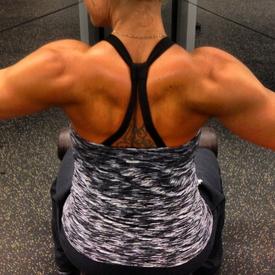A very interesting and informational read on deficits...
Replies
-
good stuff! thanks for posting0
-
Very informative. Thanks for posting. Bump.0
-
bump0
-
Great article to read for those who have little to lose. Trying to drop 2lbs a week when only 10lbs left to lose is still common amongst those who just adhere to just formulas for weight loss.
A.C.E. Certified Personal/Group FitnessTrainer
IDEA Fitness member
Kickboxing Certified Instructor
Been in fitness for 30 years and have studied kinesiology and nutrition0 -
EXCELLENT READ! THANKS SO MUCH FOR SHARING!0
-
Great article. Thanks for sharing.0
-
Great read! Thanks for sharing!
 0
0 -
bumping this to read later
 0
0 -
This was very interesting. And it makes a lot of sense. Thank you for sharing.0
-
Bumpity bump0
-
Great and informative read. Thanks!0
-
Your summary is very good. It highlighted the major points0
-
Hi Sarah. Thank you for the article. :flowerforyou:By Tom Venuto...New Research and Insights on The Optimal Caloric Deficit For Fat Losfs
...What we can do however, is to improve our calorie deficit guidelines using a sliding percentage scale of conservative, moderate and aggressive deficits, which you choose based on your starting body fat percentage...As Einstein would say, that's relativity for you.
The fix is simple, instead of using 500 or 1000 calorie per day deficits as fixed standards, use a percentage, and set up a sliding scale that accounts for your goals, your desired rate of rate of weight loss and your starting body fat percentage.
15-20% below maintenance calories = conservative deficit
20-25% below maintenance calories = moderate deficit
25-30% below maintenance calories = aggressive deficit
31-40% below maintenance calories = very aggressive deficit (risky)
50%+ below maintenance calories = semi starvation/starvation (potentially dangerous and unhealthy if not medically supervised)0 -
Great read. Thanks for posting!0
-
Yep, good summary. Review targets & settings regularly as you lose.0
-
Bump. Going to read later. In small chunks. Too many words at once for me otherwise!
 0
0 -
bump0
-
i read it but I'm not sure i understand.. how do i figure out what i should be eating a day?0
-
Tagged for later0
-
i read it but I'm not sure i understand.. how do i figure out what i should be eating a day?
You are still applying the basic method, eat less than you burn daily, on average.
This helps with making it a reasonable deficit to what you burn.
So you need best accuracy on what you eat side of the equation - so weigh all your foods except liquids that are measured.
Get best estimates for the burn side of the equation, not just exercise but daily life.
Take reasonable deficit based on what you do and amount to lose.
This will help get best estimates, and allow tracking progress. More exercise you do, more the progress will be seen in inches instead of scale. Link at bottom if you don't need the education on BMR and TDEE and why differences.
http://www.myfitnesspal.com/topics/show/813720-spreadsheet-bmr-tdee-deficit-macro-calcs-hrm-zones0 -
i read it but I'm not sure i understand.. how do i figure out what i should be eating a day?
You are still applying the basic method, eat less than you burn daily, on average.
This helps with making it a reasonable deficit to what you burn.
So you need best accuracy on what you eat side of the equation - so weigh all your foods except liquids that are measured.
Get best estimates for the burn side of the equation, not just exercise but daily life.
Take reasonable deficit based on what you do and amount to lose.
This will help get best estimates, and allow tracking progress. More exercise you do, more the progress will be seen in inches instead of scale. Link at bottom if you don't need the education on BMR and TDEE and why differences.
http://www.myfitnesspal.com/topics/show/813720-spreadsheet-bmr-tdee-deficit-macro-calcs-hrm-zones
I looked at this link and it just confused me. there isn't a simple way to find out?0 -
Bump to finish later. I read a good bit, but it is very long. What I did read seemed sensible.0
-
i read it but I'm not sure i understand.. how do i figure out what i should be eating a day?
You are still applying the basic method, eat less than you burn daily, on average.
This helps with making it a reasonable deficit to what you burn.
So you need best accuracy on what you eat side of the equation - so weigh all your foods except liquids that are measured.
Get best estimates for the burn side of the equation, not just exercise but daily life.
Take reasonable deficit based on what you do and amount to lose.
This will help get best estimates, and allow tracking progress. More exercise you do, more the progress will be seen in inches instead of scale. Link at bottom if you don't need the education on BMR and TDEE and why differences.
http://www.myfitnesspal.com/topics/show/813720-spreadsheet-bmr-tdee-deficit-macro-calcs-hrm-zones
I looked at this link and it just confused me. there isn't a simple way to find out?
No.
Unless you want to pay a lab to monitor you for a 24 hr day for energy burn, and then get your VO2max tested so you can get a nicer HRM setup correctly.
Then you'll have the figures to do this simple.
But you'd still need to log eating as correct as possible.
You want rough ball park results, then go for simple rough ball park setup.
sadly, you want results, you'll need to work to understand. Or spend a lifetime doing this again and again never learning.
Simple depends on person, get it setup right once, and make minor adjustments along the way.
Or basic setup at first, log carefully and note results, and then make adjustments along the way - probably takes longer.
Eat at 10-11 calories per pound of weight, and eat your exercise calories back.
After 4 weeks, see how much you have lost.
Calculate what your TDEE must have been to cause that loss.
Adjust accordingly.0 -
bumping for later0
-
bump0
-
Bump
for later...0 -
need to read at home...0
-
Bumping for later.0
-
bump0
-
That was a great article!! Thanks for sharing
 0
0
This discussion has been closed.
Categories
- All Categories
- 1.4M Health, Wellness and Goals
- 398.1K Introduce Yourself
- 44.7K Getting Started
- 261K Health and Weight Loss
- 176.4K Food and Nutrition
- 47.7K Recipes
- 233K Fitness and Exercise
- 462 Sleep, Mindfulness and Overall Wellness
- 6.5K Goal: Maintaining Weight
- 8.7K Goal: Gaining Weight and Body Building
- 153.5K Motivation and Support
- 8.4K Challenges
- 1.4K Debate Club
- 96.5K Chit-Chat
- 2.6K Fun and Games
- 4.8K MyFitnessPal Information
- 12 News and Announcements
- 21 MyFitnessPal Academy
- 1.5K Feature Suggestions and Ideas
- 3.2K MyFitnessPal Tech Support Questions
























